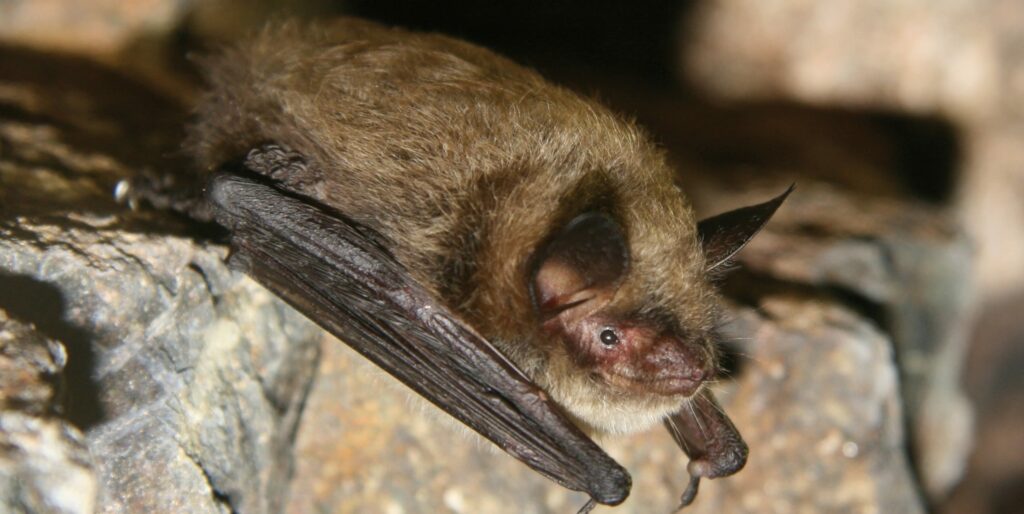As Halloween is upon us, you may be seeing lots of spooky decorations around town. One popular animal that is often associated with Halloween is the only flying mammal- the bat. Originally associated with vampires after bats were observed drinking the blood of cattle in Central and South America, the idea was solidified when Bram Stoker’s Dracula (1897) showed vampires turning into bats. Creepy!
Of the 1400 species of bats worldwide, only a few are vampire bats. The rest eat fruit, pollen, nectar, insects, and small vertebrates. Maine is home to eight species of bats, which are insectivores. Five species are hibernating bats, meaning they stay in Maine over the winter and reduce metabolic activities to survive. The other three species are tree bats and will migrate further south where food is more readily available.
Bats in Maine are specially protected by the Department of Inland Fisheries and Wildlife (MDIFW) due to their importance to the ecosystem. They are a significant pest-control service, a nursing female little brown bat can consume her body weight in insects in just one night! They have few natural predators. Hawks, owls, house cats, and raccoons will occasionally prey upon them. Anthropogenic, or human-caused, changes to the environment such as habitat alteration and pesticide use can affect bats as well.

One of the biggest threats Maine bats are facing is a fungal disease called White-nose syndrome. The fungus, Pseudogymnoascus destructans, is a cold tolerant fungus that colonizes on the nose and wings of bats when they are hibernating. The disease causes increased activity when the bats are supposed to be hibernating, and the increased activity causes the bats to deplete their fat reserves before food is available in the spring. It is transmitted from bat-to-bat contact or infected cave-to-bat contact.
MDIFW has many survey strategies to collect data on population trends for Maine’s bats. They use acoustic monitoring to record echolocation of bats and use the recordings to identify active species. They also survey caves to count bats and look for evidence of disease in the winter when the bats are hibernating. Lastly, they rely on observations and reports from the general public to identify colonies and roost sites.
If you are interested in helping bats, MDIFW has put together a great list of ways to help bats in your area.
- Minimize pesticides on lawns and gardens – all eight species of bats that live in Maine eat insects. This also helps our bees and other important pollinators.
- Keep standing dead trees on your property (aka snags). As a tree starts to die, bark separates from the tree and creates little spaces which bats use for roosting (daytime resting). Snags and eventually logs provide habitat to lots of other living things (e.g., fungus, birds, insects, salamanders, etc.).
- Maintain some mature forest on your property. Tree bats (Red, Hoary, and Silver- haired) roost in tree foliage of older trees. Older trees also can provide cavities and flaky bark for roosting.
- Spread the message that bats provide a lot of benefits like insect control.
- Prevent bats from getting into your home by sealing off cracks or holes (1/2 inch or larger). Common entry points used by bats: Down chimneys and where chimneys and other masonry meet the side of a house; joints between window frames and house siding; joints around large exterior beams; at building corners; where pipes or wires penetrate the ceiling or walls in attics; between porches or other additions and the main house; at roof edges, ridge caps, soffits, and fascia boards; where walls meet eaves at the gable ends of an attic; and in gaps under shingles.
- If you or a friend have bats roosting in their attic, avoid bat exclusion during the maternity season (May 15-August 15 in Maine), so flightless baby bats are not separated from their moms. There are one-way doors that allow bats to fly out but not get back in.
- Don’t visit caves in winter (October 1-April 30)- this is the time of year that hibernating bats need to conserve all their energy. Any disturbance can cause bats to use up precious energy reserves and starve to death.
- Build or buy a bat house when you exclude a bat colony from your house, but make sure to do your research first.
For more information and fun, bat themed activities, visit https://batweek.org/
